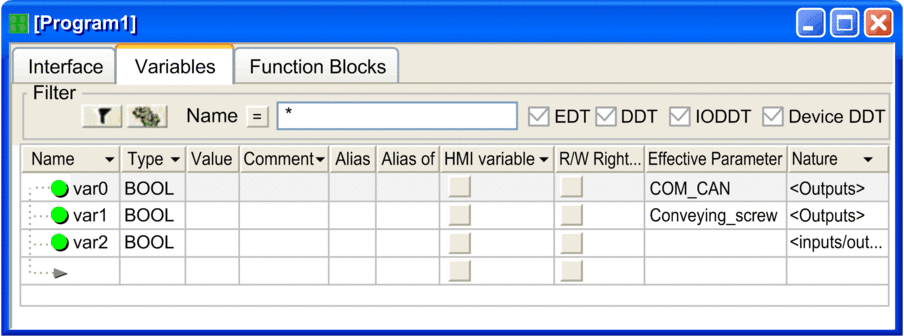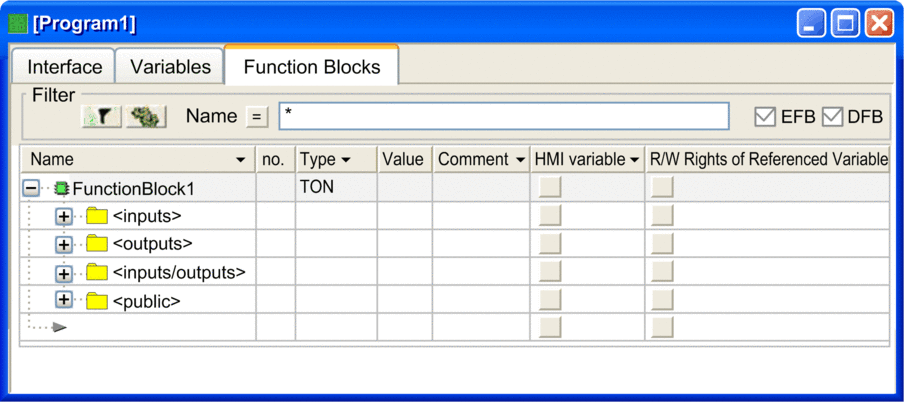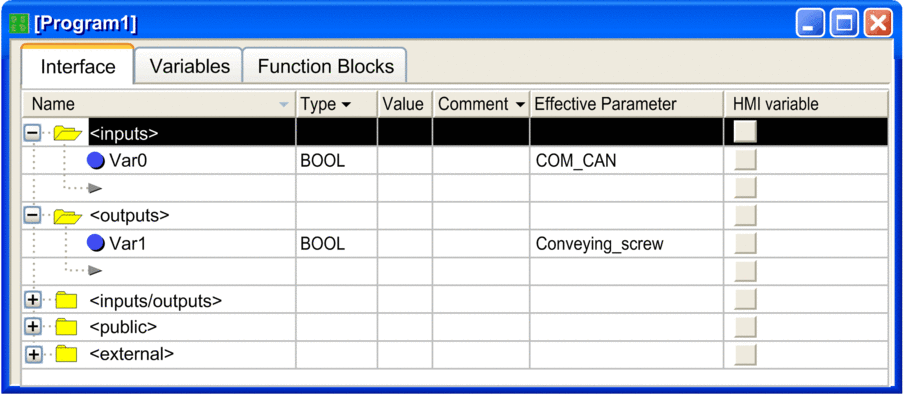Introduction
Tab: Variables
The tab enables the management of all the variables that belong to the Program Unit:

Description:
Element |
Description |
|---|---|
Filter |
|
Button  |
Clicking on this button updates the display corresponding to the filter term defined in the field. |
Button  |
Clicking on this button opens a dialog box for defining the filters. |
Button  |
Clicking on this button inverts the filter. The button changes from = to <> and vice versa. |
Name |
Column where you enter the name (symbol) of the variable you want to display. You can use the place holders (* or ? for this.). |
EDT |
Displaying variables with elementary data types |
DDT |
Displaying variables with derived data types |
IODDT |
Display the variables with derived data types (DDT) that reference inputs/outputs |
Device DDT |
Display the variables with device derived data types |
Properties |
|
Name |
Column where you enter the name (symbol) of the variable. |
Type |
Column where you select the variable type. |
Value |
Column where you initialize the variable. |
Comment |
Column where you enter the comment for the variable. |
Alias |
Column where you can change the name of a variable. Only for variables. |
Alias of |
Column where you enter the complete path of the variable subfield on which you set Alias attribute. |
HMI variable |
Column where you check if the variable is embedded in the data dictionary. |
R/W Rights of Referenced variable |
Column where you set the access rights of a reference type variable. |
Effective Parameter |
Column where you can assign a variable to the Program Unit parameter. |
Nature |
Column where you set the nature of the Program Unit variable. |
The above properties are displayed by default, for customized properties, refer to Configuring the Data Editor columns. |
|
Tab: Function Blocks
The tab enables the management of the instance of elementary and derived function blocks used in the sections of the Program Unit:

Description:
Element |
Description |
|---|---|
Filter |
|
Button  |
Clicking on this button updates the display corresponding to the filter term defined in the field. |
Button  |
Clicking on this button opens a dialog box for defining the filters. |
Button  |
Clicking on this button inverts the filter. The button changes from = to <> and vice versa. |
Name |
Column where you enter the name (symbol) of the instance or the data type you want to display. You can use the place holders (* or ? for this.). |
EFB |
Displaying elementary data types |
DFB |
Displaying derived data types |
Properties |
|
Name |
Column where you enter the name (symbol) of the function block instance. |
no. |
Order number of the inputs and outputs of the function block. |
Type |
Column where you select the function block type. |
Value |
Column where you enter the initial value for the variable. |
Comment |
Column where you enter the comment for the variable. |
HMI variable |
Column where you check if the variable is embedded in the data dictionary. |
R/W Rights of Referenced variable |
Column where you set the access rights of a reference type variable. |
The above properties are displayed by default, for customized properties, refer to Configuring the Data Editor columns. |
|
Tab: Interface
The tab enables the management of the Program Unit variables sorted by :

Description:
Element |
Description |
|---|---|
Properties |
|
Name |
This column contains the Column where you set the nature of the Program Unit variable. Column where you enter the name (symbol) of the variable. |
Type |
Column where you select the variable type. |
Value |
Column where you initialize the variable. |
Comment |
Column where you enter the comment for the variable. |
Effective Parameter |
Column where you can assign a variable to the Program Unit parameter. |
HMI variable |
Column where you check if the variable is embedded in the data dictionary. |
The above properties are displayed by default, for customized properties, refer to Configuring the Data Editor columns. |
|


